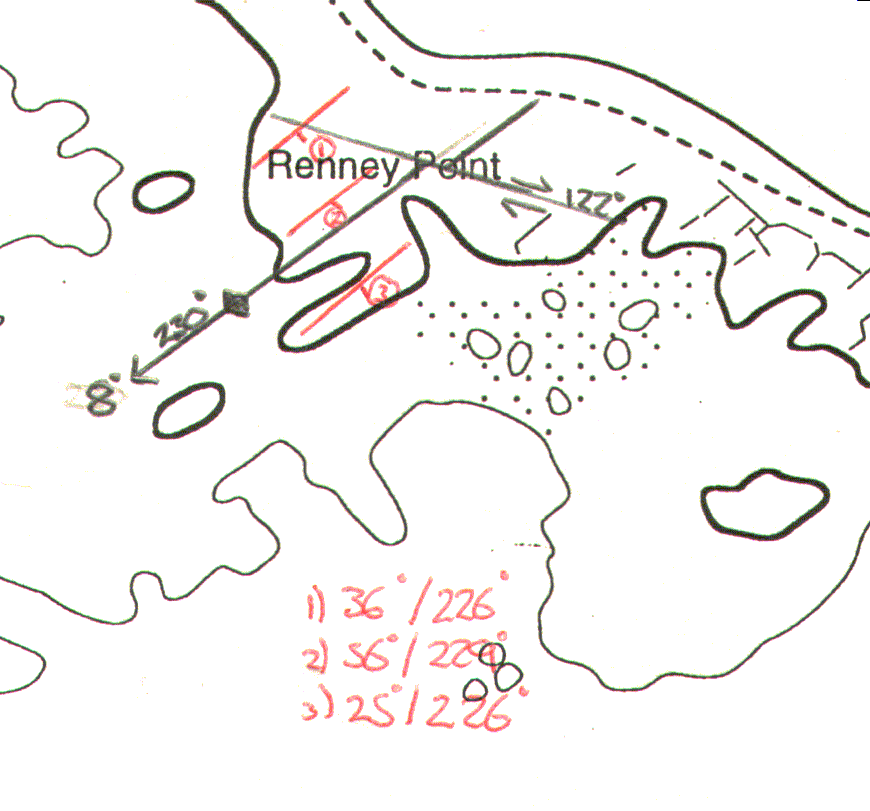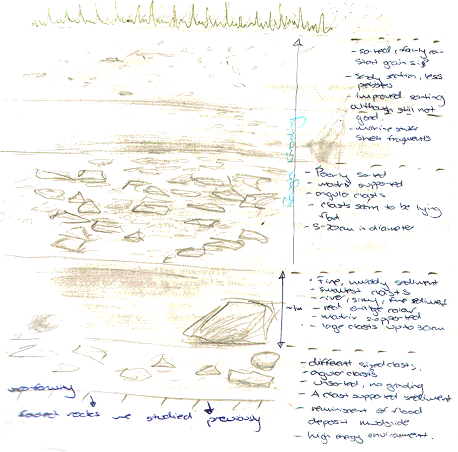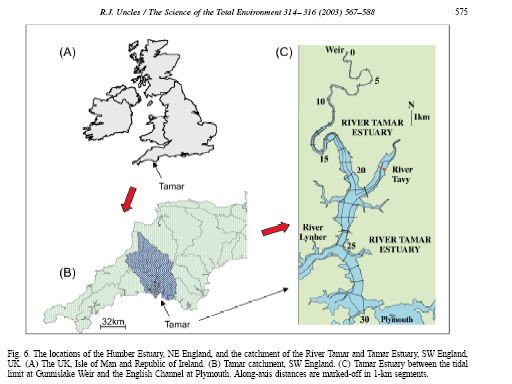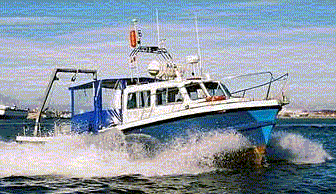Jo, Charlotte, Alex, Tom, Oli, Jenny, Helen, Rachel and Sarah
| Abstract |
| Introduction |
| Geofield |
| Estuarine Environment |
| Offshore Environment |
| Coastal Environment |
| Geophysics |
| Conclusion |
| References |
The main aim
of this practical exercise was to gain a holistic view of the River Tamar
estuary and adjacent coastal region, and study the associated processes. The
sampling and surveying ranged from the head of the salt water intrusion (a
salinity of 0.16) to the E1
monitoring point (50.02.070N 4.52.535W), approximately 25 kilometres offshore. A
variety of sampling and data collection methods were utilised, notably CTD, ADCP,
T-S probes, Side-Scan Sonar, plankton nets and nutrient sampling. The data was
then analysed to produce a complete picture of the entire estuary.
The
survey of the upper estuary showed evidence of a salt wedge during the incoming
tide, as well as temperature profile, with a change of 0.5°C
from the warmer riverine water to the cooler estuarine waters. The nutrients
showed very different results: Silicate showed non-conservative behaviour, with
removal in the upper estuary probably due to uptake by diatoms. Phosphate also
showed non-conservative behaviour, with both addition and removal associated
with areas of past and present industrial use. Nitrate showed slight addition in
the upper estuary, with slight removal in the lower estuary due to uptake by
plankton as well as de-nitrification which reaches a maximum during summer. The
plankton data showed an inverse relationship between the zooplankton and
phytoplankton due to grazing. There is a difference in species dominance
throughout the estuary. Diatoms show dominance in the upper estuary, with 75% of
the total abundance, where Dinoflagellates dominate in the lower estuary, with
90% of the total abundance. Copepods tend to be the dominant zooplankton species
throughout the entire estuary.
The
offshore survey showed a phytoplankton bloom extending from the mouth of the
estuary, offshore to a water depth of 50 meters, as well as various other areas
of backscatter indicating plankton maxima at depth. At the E1 monitoring station
we recorded a very distinct thermocline at a depth of 29 meters, with
fluorescence maxima (4.0 micrograms per litre) at 28 meters. This fluorescence
maxima coincided with a backscatter peak from the ADCP data indicating
zooplankton grazing. The fluoresence maxima occurs just above the thermocline
because nutrients leach slowly through it, enabling the phytoplankton to take
advantage of the available nutrients. In the zooplankton net that was taken in a
vertical plane through this backscatter peak a huge abundance of large
unidentified cnidarian plankton was found, which were approximately 2cm in
diameter. Backscatter peaks were also identified above the two peaks of
Eddystone Rocks which were covered; this coincided with a decrease in the depth
of the chlorophyll maxima which was noted on the miniBAT transect in the same
area.
The major freshwater inputs to the Tamar estuary are the Rivers Tamar, and the Tavy and Lyner which are sub estuaries which junction with the Tamar. The yearly averaged runoff from the River Tamar based on runoff records for 1976-1990 is 22 m³s‾¹ and the Tavy and Lyner contribute and additional 27 and 23% of the Tamar’s flows respectively (Uncles et el 2001).
Tides in the Tamar estuary are semidiurnal, with mean neap and spring ranges of 2.2 and 4.7m respectively. The Intra-tidal variations in total water depth are therefore considerable in the shallow, upper reaches (Uncles et al 2001).The water transport on the flood tides separates at the junction of the Lyner and Tamar in the ratio of approximately 30 and 70% respectively. This ration is approximately the same for the junction of the Tavy and Tamar (Uncles et al 2001).
During the summer months, the inshore waters of Plymouth Sound, tend to be dominated by a halocline. However, further offshore, thermal stratification starts to dominate. Current speeds are strongly influenced by the bathymetry of the Sound and subsequently in combination with wave action influence the distribution of bottom sediments. Fluvial input is relatively small and it is suggested that coastally derived sediment brought into the sound during severe storms, locally eroded material and a small yet important anthropogenic input in the form of eroded material from the breakwater and ship ballast, make up the bottom sediments (Allen et al 2003).
The geology around
Aims
The
Aims of this field trip are relatively straight forward,
|
|
Aims
Methods
Results At Renney Point initial investigation was to take a dip and strike of some of the rocks exposed on the shore. This was mainly used as an instructional section as to how to use the compass clinometer. Initially a strike of 226º and a dip of 36º were found, another set of measurements were conducted approximately 30 meters to the southwest of the first point and a strike of 226º and a dip of 25º were found. In between these two sets of measurements there was one very noticeable geological structure - an antiform fold. The axial trace of the fold was orientated to 230º and was plunging to an angle of 8º in the same direction. However, further up the beach the fold stopped at a trench within the rocks. This was a fault line that ran through the entire section of the rocks. The fault was a right lateral fault, otherwise known as a right dextral fault. The fault was orientated to 118º and had an approximate displacement of 5 meters. These results are shown on the geological plan. (shown in fig 4): |
|
||||||||||||||
| Fig. 3 - Image of axial trace of the fold | |||||||||||||||
 |
|||||||||||||||
| Fig. 4 - Geological plan of Renney Point | |||||||||||||||
|
|
|||||||||||||||
| Fig. 5 - Right dextral fault |
 |
Within the main fold that was studied a series of stress fractures were found. These all appeared to be orientated in similar directions. The orientation angles varied between the two maxima of 80º and 160º. This common direction of fracture is due to the direction from which the rock unit was forced in the past. In order for the fold to have a strike of 230º, the stress must have been applied in the 140 to 320º approximate direction. This would suggest that the fractures of the higher angles occurred first. It would also suggest that following this period of stress, the angle from which the stress was applied changed, thus producing the fractures at the lower angles. This statement can be reinforced by applying the law of cross cutting relationships. Two intersecting stress fractures were found. The law of cross cutting relationships states that when one rock fracture cross cuts another, the one that does the cross cutting is the younger. In the field a 147º fracture was intersected, and slightly displaced by the fracture at 97º. This shows that the the angle of stress applied to the fold changed over time. |
|
| Fig. 6 - Illustration of the sediment exposure | Fig. 7 - Image of the sediment exposure with person to scale | |
Once the hard rock geology was analysed, a survey was completed of the sediment overlying the rocks. It was deposited from a periglacial environment during the latest period of glacial advance. This was the Pleistocene period which was at its maximum extent 18000 years before present. The sediment face was sketched and detailed observations were made. These are shown on the illustration below of the sediment exposure (Fig. 6) which was approximately 3.5 meters from top to bottom.

|
Introduction The investigation was conducted on the 26th June 2004, the weather in the morning was persistent rain, overcast, with 8/8 cloud cover. The afternoon brought intermittent showers, persistent drizzle with very low cloud cover (8/8). The winds were varying from 0 m/s to 7m/s with a direction ranging from 110° to 190°.Two RIBS were used to cover this 21 kilometre stretch to allow access to the upper reaches of the river. High tide (on the neap cycle) was at 11:22 GMT and therefore it was decided to travel to the furthest point upstream at the start and return towards Plymouth sampling on the way. |
|||||||||||||||||||||
|
|
Aims
Methods
|
||||||||||||||||||||
| Fig. 8 - Image of the riverine end member of the Tamar estuary | |||||||||||||||||||||
 |
|||||||||||||||||||||
|
Fig. 9 - Tamar estuary location and catchment |
|||||||||||||||||||||

Terschelling |
Introduction The Terschelling data was collected on the
29th of June 2004 between 0900 and 1700 GMT. Thermal stratification (especially during
the summer months) is very dominant in waters off The aim of this trip offshore was to
determine how vertical mixing processes in the waters off Plymouth affect,
directly and indirectly, the structure and functional properties of plankton
communities in the coastal waters of the western English Channel. |
|
Methods
|
Minibat |
||||||||||||||
CTD |
|
Acoustic
Doppler Current Profiler Data As one can
clearly see in figure 20, there is a tongue region of high backscatter that protrudes from
the mouth of the estuary. This shows that there is some suspended material
within the water column that is interfering with the beam of the ADCP. The next
step is to find the origin of that material: land derived suspended sediment, or
a plankton bloom, that is utilizing the nutrient rich estuarine waters, and
extending out into the more oceanic, nutrient depleted waters. To investigate
this it is necessary to study the CTD profile data for turbidity and fluorescence that
was found at station 1. This shows that the profile for fluorescence is
practically identical to that of the turbidity. This indicates that the water
column turbidity is almost entirely due to the suspended phytoplankton within
the water. Thus the high backscatter is indeed a planktonic bloom extending from
the nutrient rich estuarine waters, out into nutrient depleted, coastal waters. Figure 21 shows the ADCP backscatter data for our second sampling site, E1. As is clearly visible there is a region of higher backscatter at approximately 28 meters. It was suspected that this was a layer of dense zooplankton, so a plankton net was used to sample through this layer from 35 to 20 meters. This sample produced some very interesting results. It was calculated that for this particular trawl, a volume of 3.2m3 of water passed trough the net. Within the sample approximately 300 unidentified cnidarian plankton were found, of approximately 2cm diameter. It was likely that this plankton species was responsible for the strong backscatter of the emitted pulse. A similar scenario was observed at sample site 3 (see figure 22) at a depth of 10 to 13 meters. This final transect recorded data between sites 3 and 4, travelling northwards to the west ofTwo peaks
were found in backscatter above the shallowest sections of the A velocity peak around the
|
|
| Fig. 20 - ADCP Section showing backscatter tongue | |
|
|
|
| Fig. 21 - ACDP Section showing jellyfish backscatter | |
|
|
|
| Fig. 22 - ADCP section showing shallow backscatter peaks | |
|
|
|
| Fig. 23 - ADCP Section showing backscatter maxima |
|
Table
1: the changing dominance of species with depth at site 2 (E1) |
||
|
depth |
Copepods
% abundance |
Dinoflagellates
% abundance |
|
surface |
0.8 |
97 |
|
35 –
20m |
18 |
70 |
|
56 –
35m |
85 |
1.8 |
The relative
abundance of copepods increases with depth at site E1, as the dominance of
dinoflagellates decrease shown in table 1. This major change in abundance occurs
over a dense layer of cnidaria and other jellies. Copepods feed by filtering
phytoplankton and protists from the water column or by carnivory,
(Miller, 2004). Small jellyfish are part of the
copepod diet and would supply a food source to
Copepods in waters where other species are lacking in food sources. The rise in
Copepods could have led to the dominance shifting away from the dinoflagellates,
out competing them for space.

|
Introduction As with the previous two boat
practicals (RIBS and Tershelling) measurements were taken of the water
properties (temperature, salinity and depth), current velocity distribution,
light attenuation, inorganic nutrients, dissolved oxygen, chlorophyll a and
plankton abundance along horizontal (surface) transects and vertical profiles.
This has allowed an understanding of how the Tamar estuary acts as a
transition zone between the freshwater input and the coastal sea to be
developed. Aims The aim was to continue with
measurements as mentioned above in order to complete an entire analysis of the
area from the River Tamar, through the estuary to a point (E1) 10 miles
offshore. Methods The methods for Conway were the same as Terschelling but the Minibat was not used.
|

Bill Conway |
|
Results ADCP Profiles Our
first ADCP transect was conducted just behind the breakwater across Plymouth
Sound. The figure below shows a velocity magnitude contour plot, as well as a
stick diagram, which represents the ships track, along with water flow direction
and magnitude at a depth of 1.79 meters. However, things are not as
clear cut as two separate streams of water flowing seaward. The plot of velocity
direction below shows the direction of water flow for the entire water column
for the transect. The majority of the plot shows a flow of around 180°,
indicating a southerly flow of water, but the yellow section in the center
appears to show a reverse of flow, in that the water was flowing upstream. This
is believed to be related to the presence of the breakwater.
It is believed that part of the
flow ebbing from the estuary on the western side strikes the very end of the
breakwater. This fast flowing water is subducted down the face of the breakwater
and then flows in a northerly direction, against the southerly flowing tide, at
depths of 9 to 13 meters. Due to the high
precipitation that occurred in the From the velocity magnitude contour plot we can see that the flow that was traveling upstream, against the tide, had a much reduced rate of flow when compared to the tidal flow itself. It is therefore not unreasonable to assume, that due to the reduced flow rates, the upstream flow would be supporting less sediment in suspension when compared to the tidal flow. This assumption is confirmed by the backscatter data (Fig. 32), which shows high backscatter in the upper layers, where the ebbing tide is carrying suspended sediment. The lower layers show much less backscatter indicating greatly reduced suspended load. This assumes that the sediment is being deposited where the water changes from high to low velocity. The location of this velocity change is likely to be the point where the flow comes into contact with the breakwater. Thus one would expect there to be a region of coarse grained sedimentary deposition just inshore of the breakwater. This will be investigated during the geophysics practical.
|
|
| F |
|
| Fig.31 - Velocity direction | |
| Fig.32 - Average Backscatter |

|
Results On the 6th of July of 2004, a side scan sonar survey was carried out, covering an area of approximately 1800 metres by 200 meters, just inshore of the Plymouth Breakwater. Four transects were completed, incorporating several interesting features of the sediment bathymetry. The plot is shown in figure 42. The first
notable feature found was the base of the breakwater itself. Both ends of the
breakwater were scanned and showed up on the plots, and these are represented on
the plotted diagram by a green colour. A transect close enough to the breakwater
was not completed therefore the entire length was not plotted, but both ends are
clearly shown. Surrounding these ends are areas of coarse-grained sediments.
These sediments have been deposited by water flows that are slowed by the
presence of the breakwater itself, and thus can no longer support its sediment
load in suspension. Also found was some bedrock that was exposed above the
sediments behind the breakwater, shown in black, along with the base of the
moorings used by the large Naval vessels that anchor in this area, as well as
the base of the fort built behind the breakwater during the first world war. |
Fig. 42 - |
The main point
of this investigation, as described in earlier sections of this website, was to
look for evidence of sediment deposition by the flow of water that eddies back
upstream on ebb tides at the western side of the breakwater. This was
investigated because, using our ADCP data on the ebbing tide, evidence was found
of a back eddy that was carrying much less sediment than the main flow. At this
time of year, such occurrences would not normally be happening, but due to the
high rates of precipitation that occurred prior to and during our investigation,
there were raised levels of suspended sediment in the water column. The findings
were not entirely as expected.
It was hoped
that there would be a large amount of sediment deposition inside of the
breakwater, but this was not apparent from the scan data. However, evidence of
sediment deposition was found upon two large-scale bedforms. These bedforms were
set further back from the breakwater than was initially expected. The sediment
appears to have been deposited on top of a scour feature that has incised into
the sediment. This incision was estimated to be approximately 1 meter. Within
the main scour, smaller scours were noted and are illustrated on the diagram.
The two main scours are approximately 360 meters in width at the widest point
found by this survey. The smaller scours are 10 to 20 meters long and appear to
have formed around a nuclei of some sort.
|
A grab was taken in the middle of the eastern most scour feature at a position of 50°20.179N, 4°08.748W to find any evidence of sediment deposition. Figure 43 shows our collected sample. There
is a thin layer of very fine, brown sand, which has been deposited on top of
thick layers of black muds, which become anoxic with increasing depth. It was
concluded that the brown sands on the surface was the sediment that was
suspended within the water column during the investigation on
|
Fig. 43
- |

This study
extended from 0 salinity at the head of the estuary, out to 34 salinity at E1,
and links the physical processes over the two week period with changes in the
biological, chemical and sedimentary processes.
The
survey of the upper estuary showed evidence of a salt wedge during the incoming
tide, as well as temperature profile, with a change of 0.5°C from the warmer
riverine water to the cooler estuarine waters. The nutrients showed very
different results: Silicate showed non-conservative behaviour, with removal in
the upper estuary probably due to uptake by diatoms. Phosphate also showed
non-conservative behaviour, with both addition and removal associated with areas
of past and present industrial use. Nitrate showed slight addition in the upper
estuary, with slight removal in the lower estuary due to uptake by plankton as
well as de-nitrification which reaches a maximum during summer. The plankton
data showed an inverse relationship between the zooplankton and phytoplankton
due to grazing. There is a difference in species dominance throughout the
estuary. Diatoms show dominance in the upper estuary, with 75% of the total
abundance, where Dinoflagellates dominate in the lower estuary, with 90% of the
total abundance. Copepods tend to be the dominant zooplankton species throughout
the entire estuary.
The breakwater
appears to have a significant effect on the flows in the Sound and the
surrounding channels. During the ebb tide, observations of the ADCP backscatter
suggest a reversal of flow direction inside the breakwater, with turbulent
mixing and scouring of the seabed occurring.
During the
period of this study there was a large amount of precipitation for this time of
year. Consequently there was a larger quantity of suspended sediment within the
freshwater source. This increase in sediment lead to previously unobserved
deposition of fine grain sediments on top of these scour features, themselves
also previously unseen on side scan surveys.
The offshore survey showed a phytoplankton bloom
extending from the mouth of the estuary, offshore to a water depth of 50 meters,
as well as various other areas of backscatter indicating plankton maxima at
depth. At the E1 monitoring station we recorded a very distinct thermocline at a
depth of 29 meters, with fluorescence maxima (4.0 micrograms per litre) at 28
meters. This fluorescence maxima coincided with a backscatter peak from the ADCP
data indicating zooplankton grazing. The fluoresence maxima occurs just above
the thermocline because nutrients leach slowly through it, enabling the
phytoplankton to take advantage of the available nutrients. In the zooplankton
net we took in a vertical plane through this backscatter peak we found a huge
abundance of large unidentified nidrian plankton, which were approximately 2cm
in diameter. Backscatter peaks were also identified above the two peaks of
Eddystone Rocks which were covered; this coincided with a decrease in the depth
of the chlorophyll maxima which was noted on the miniBAT transect in the same
area.

Kiorboe,
T. (1993). Turbulence, phytoplankton size, and the structure of pelagic
food webs. Adv. Mar. Biol. 29, 1-72.
Miller, C.B. (2004). Biological Oceanography, Blackwell. pg 120.
Holligan P.M. et al. (1984). Photosynthesis, respiration and nitrogen supply of plankton populations in stratified, frontal and tidally mixed shelf waters. Marine Ecology-Progress Series. Vol. 17:201-213.
Fretter,
V and Shale, D. (1973), Seasonal
changes in the population density and vertical distribution of prosobranch
veligers in offshore plankton at
Dyer, K.R (1994). Sediment Transport Processes in Estuaries. In Geomorphology and Sedimentology of Estuaries Perillo, G. M. E. (ed) Elsevier
Tattersall G. R, Elliot A. J and Lynn N. M. (2003) Suspended sediment concentrations in the Tamar estuary, Estuarine Coastal and Shelf Science, 57, pp 679-688
Bautista, B. et al, (1994), Temporal variability in copepod fecundity during two different spring bloom periods in coastal waters of Plymouth, Journal of Plankton Research, Vol.16 no.10, pp.1367-1377
Fretter,
V and Shale, D. (1973), Seasonal
changes in the population density and vertical distribution of prosobranch
veligers in offshore plankton at
Maddock,
L. et al, (1989), Seasonal and year-to-year changes in the phytoplankton from
the